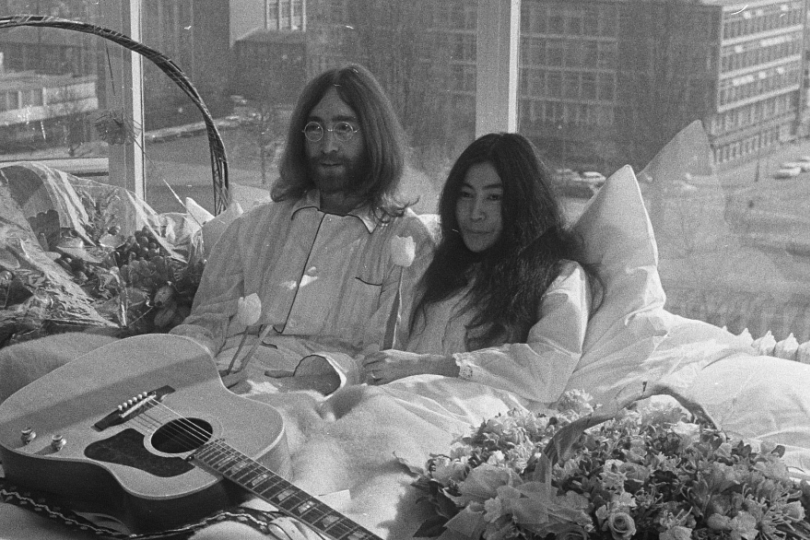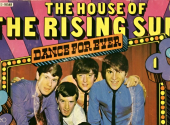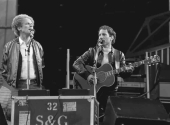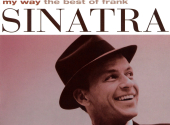
Story of a Hit #18: "Imagine"
In 1971, John Lennon wrote a song in one morning, that would almost overshadow all of his work with The Beatles in the decades before. Voted the number 3 greatest song by Rolling Stone magazine in 2004, its 3 minutes of delicate musical meandering is almost perfect. It's a song that expresses a simple but radical idea and has been used countless times to voice a humanitarian message that the world still sorely needs.
John Lennon needs no introduction, nor does his most famous song. It's an anthem that has travelled the globe, sending a message of peace and an idea of society that is both beautiful and somewhat naive in its nature.
However, the simplicity of its message is what makes it so appealing. A call to imagine a world where things like possessions and religion don't control people, but rather to "imagine all the people, living for today".
How was it written?
Initial ideas for the chord progression emerged in 1969, during the recording of the final Beatles album, Let It Be. In 2003, Let It Be... Naked was released, and alongside it a bonus CD which included various short tracks of the Beatles chatting, playing and experimenting with musical ideas. On it, you can hear the early ideas of "Imagine" (at about 6:00).
John Lennon supposedly wrote most of the music and lyrics in one session, in 1971. In his own words, he was inspired by the writings of his wife Yoko Ono, specifically, various poems from her 1964 book Grapefruit. One of those poems was actually printed on the back of the original EP: "Imagine the clouds dripping, dig a hole in your garden to put them in".
While Ono didn't initially receive songwriting credits, Lennon later admitted that much of the idea of the song, as well as many of the lyrics, had actually come from her. He said: "A lot of it [...] came from Yoko, but in those days I was a bit more selfish, a bit more macho, and I sort of omitted her contribution, but it was right out of Grapefruit." Ono was credited as a joint songwriter in 2017.
A history of songs with a message for the world
Imagine wasn't the first "protest" song Lennon released, as his relationship with Yoko Ono contributed to him finding a new voice in his songwriting. During their famous Bed-ins for Peace, a sort of publicised honeymoon that John and Yoko performed as a peaceful protest against the Vietnam War, they composed and recorded "Give Peace a Chance", which would go on to become an anthem for the anti-war movement in 1970s America.
Of course, he had also written the song "Revolution" back in 1968, released on the Beatles album Hey Jude, and later "Power to the People" (1971), which only just stopped short of calling for an actual revolution. He wrote "Power" as a response to an interview he gave with the political activist Tariq Ali, and the lyrics are quite a step up from the non-confrontational approach of the previous "Revolution". He later called the song "rather embarrassing", and in 1980 he said that it had been "written in the state of being asleep and wanting to be loved by Tariq Ali and his ilk".
Lennon's views and music repeatedly put him in the spotlight, which of course helped his success as a solo artist in his post-Beatles years, but also suited his desire to spread his views. It even led the US government to investigate him for his involvement in radical left politics, allegedly because Richard Nixon believed he could cost him his reelection – the U.S. government embarked on a 4-year attempt to have him deported and prevented his request to become a permanent resident. He was an extremely important anti-war and left-wing figure in the 1970s, and his music repeatedly became a rallying call for people who shared his views.
His most radical work?
But it was with "Imagine" that Lennon doubled down on his message for the world, in what is arguably his most radical song. The lyrics ask us to imagine a world without borders, with no possessions, with nothing to kill or die for – you can only imagine (pun intended) how that was received in Vietnam-era U.S.
But possibly the idea of a world without religion is the most radical – a world without heaven and hell and the religious morality that has governed civilisation for most of history. The World Church apparently asked Lennon to change the lyrics from "imagine no religion" to "imagine one religion", to which he passionately refused, saying they had completely missed the message of his song.
But despite its radical ideas, "Imagine" managed to soften its message in such a way, that turned it into an anthem for peace and goodwill all over the world. Arguably, that's down to the chorus, which switches focus, no longer asking us to imagine a radically alternate world, but instead becoming a personal and humbling self-reflection.
The chorus uses a beautiful 4-chord progression, moving from F, to G, to C, and turning around with E7, creating a bittersweet contrast, that expresses in a way, what 1000 words might struggle with.
"You may say I'm a dreamer
But I'm not the only one
I hope someday you'll join us
And the world will be as one."
Lennon was a dreamer, a dreamer with big ideas and a talent for expressing them in innovative musical ways. With "Imagine" he captured those ideas and that dream perfectly, and with it captured the imagination of generations of pacifists and freethinkers, arguably more than any single song has in history.
What do you think, is "Imagine" the most important song of peace and goodwill? Is it Lennon's greatest hit? What would you pick?
Leave your opinion in the comments below!
If you have found an error or typo in the article, please let us know by e-mail info@insounder.org.





